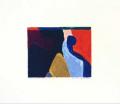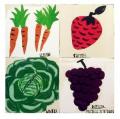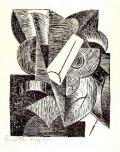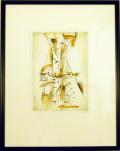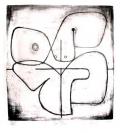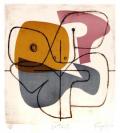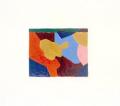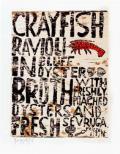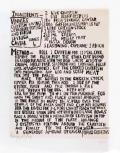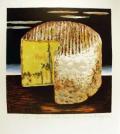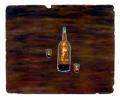enquiries@muka.co.nz
FRIZZELL, Dick
Nationality: New Zealand
Website: Website
New Zealand artist
Born in Auckland 1943
Lives and works in Napier
“Serious art sucks” reads a painting on the back inside cover to a Dick Frizzell catalogue published on the occasion of the opening of his retrospective, “Dick Frizzell: Portrait of a serious artiste” just in case you’d missed the “e” at the end of artist.
Dick Frizzell is serious. Serious about not being serious, serious about life and about taking a stance in this; his own.
Frizzell is notoriously difficult to categorize. Over the years he has explored popular iconography – international and uniquely New Zealand – abstraction, comic book styles and landscapes. From an art theory point of view these have all been marginal choices; not serious enough, cultural harlotry and – yuck! – way too popular. Dick Frizzell would not give a stuff.
Art school trained, Dick Frizzell spent eight years in the animation and advertising industry. Conventionally seen as involving a “prostitution” of noble artistic talent, Frizzell found in it excitement, technical opportunities and plain fun, not quite as prevalent in the hallowed halls of art institutions. It not only brought him money, it honed his instinct for popular visual vocabulary which he came to see as equipping him for the task he set himself artistically.
From the start Frizzell took a stand against sanctification of and by art. He rejects the grandiose transcendental themes found in the works of McCahon and Fomison in favour of a mortal, commercial, accessible and enjoyable subject matter. Fish can labels provide an opportunity to explore depth, colour and composition without “wannabe” pretension. Cartoon style personal narratives track personal fantasies and actual journeys.
The apparent banality of his subject matter contrasts with the sharpness of its execution. Though often preferring commercial, “cheaper” materials Frizzell’s works are executed with a precision and skill left over from advertising deadline days.
During the late eighties after a health crisis. Frizzell turned away from the personal to landscape painting. His images of rural New Zealand are popularly well received, earning him several regional art prizes, but they are scorned by the critics. Landscape painting is not exactly fashionable in the world of high art.
Frizzell knows the art world and he knows his public. He is just as ready to challenge the former in his choice of genre as he is to provoke the latter with his own personal brand of humour and insight.
His 1992 exhibition entitled “Tiki” kicked up an, until then, carefully circumvented desert of dust pertaining to the cultural ownership of images. Frizzell goes with his art where life takes him, no holy ground, no sanctified art, no one-way tapu.
He is a true iconoclast.
Born in Auckland 1943
Lives and works in Napier
“Serious art sucks” reads a painting on the back inside cover to a Dick Frizzell catalogue published on the occasion of the opening of his retrospective, “Dick Frizzell: Portrait of a serious artiste” just in case you’d missed the “e” at the end of artist.
Dick Frizzell is serious. Serious about not being serious, serious about life and about taking a stance in this; his own.
Frizzell is notoriously difficult to categorize. Over the years he has explored popular iconography – international and uniquely New Zealand – abstraction, comic book styles and landscapes. From an art theory point of view these have all been marginal choices; not serious enough, cultural harlotry and – yuck! – way too popular. Dick Frizzell would not give a stuff.
Art school trained, Dick Frizzell spent eight years in the animation and advertising industry. Conventionally seen as involving a “prostitution” of noble artistic talent, Frizzell found in it excitement, technical opportunities and plain fun, not quite as prevalent in the hallowed halls of art institutions. It not only brought him money, it honed his instinct for popular visual vocabulary which he came to see as equipping him for the task he set himself artistically.
From the start Frizzell took a stand against sanctification of and by art. He rejects the grandiose transcendental themes found in the works of McCahon and Fomison in favour of a mortal, commercial, accessible and enjoyable subject matter. Fish can labels provide an opportunity to explore depth, colour and composition without “wannabe” pretension. Cartoon style personal narratives track personal fantasies and actual journeys.
The apparent banality of his subject matter contrasts with the sharpness of its execution. Though often preferring commercial, “cheaper” materials Frizzell’s works are executed with a precision and skill left over from advertising deadline days.
During the late eighties after a health crisis. Frizzell turned away from the personal to landscape painting. His images of rural New Zealand are popularly well received, earning him several regional art prizes, but they are scorned by the critics. Landscape painting is not exactly fashionable in the world of high art.
Frizzell knows the art world and he knows his public. He is just as ready to challenge the former in his choice of genre as he is to provoke the latter with his own personal brand of humour and insight.
His 1992 exhibition entitled “Tiki” kicked up an, until then, carefully circumvented desert of dust pertaining to the cultural ownership of images. Frizzell goes with his art where life takes him, no holy ground, no sanctified art, no one-way tapu.
He is a true iconoclast.




